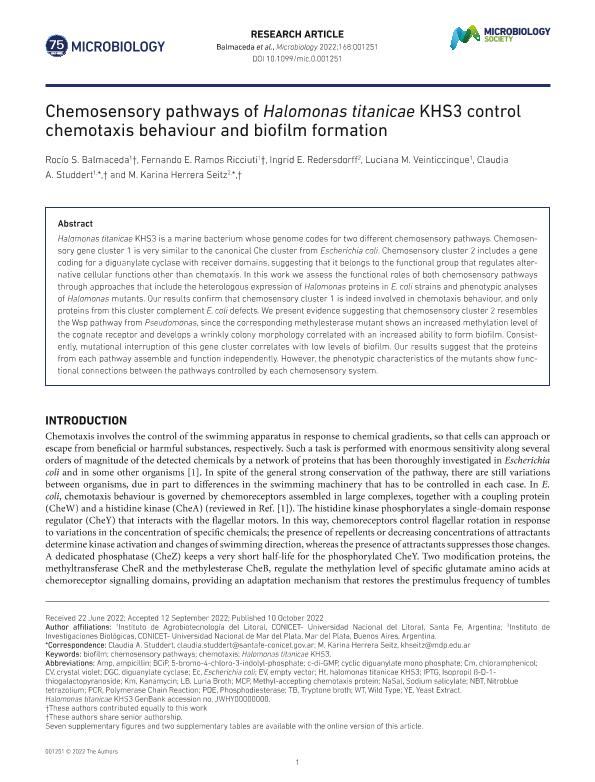Artículo
Chemosensory pathways of Halomonas titanicae KHS3 control chemotaxis behaviour and biofilm formation
Balmaceda, Rocio Soledad ; Ramos Ricciuti, Fernando Ezequiel
; Ramos Ricciuti, Fernando Ezequiel ; Redersdorff, Ingrid Emelin; Veinticcinque, Luciana; Studdert, Claudia Alicia
; Redersdorff, Ingrid Emelin; Veinticcinque, Luciana; Studdert, Claudia Alicia ; Herrera Seitz, Karina
; Herrera Seitz, Karina
 ; Ramos Ricciuti, Fernando Ezequiel
; Ramos Ricciuti, Fernando Ezequiel ; Redersdorff, Ingrid Emelin; Veinticcinque, Luciana; Studdert, Claudia Alicia
; Redersdorff, Ingrid Emelin; Veinticcinque, Luciana; Studdert, Claudia Alicia ; Herrera Seitz, Karina
; Herrera Seitz, Karina
Fecha de publicación:
10/10/2022
Editorial:
Society for General Microbiology
Revista:
Microbiology-UK
ISSN:
1350-0872
e-ISSN:
1465-2080
Idioma:
Inglés
Tipo de recurso:
Artículo publicado
Clasificación temática:
Resumen
Halomonas titanicae KHS3 is a marine bacterium whose genome codes for two different chemosensory pathways. Chemosensory gene cluster 1 is very similar to the canonical Che cluster from Escherichia coli. Chemosensory cluster 2 includes a gene coding for a diguanylate cyclase with receiver domains, suggesting that it belongs to the functional group that regulates alternative cellular functions other than chemotaxis. In this work we assess the functional roles of both chemosensory pathways through approaches that include the heterologous expression of Halomonas proteins in E. coli strains and phenotypic analyses of Halomonas mutants. Our results confirm that chemosensory cluster 1 is indeed involved in chemotaxis behaviour, and only proteins from this cluster complement E. coli defects. We present evidence suggesting that chemosensory cluster 2 resembles the Wsp pathway from Pseudomonas, since the corresponding methylesterase mutant shows an increased methylation level of the cognate receptor and develops a wrinkly colony morphology correlated with an increased ability to form biofilm. Consistently, mutational interruption of this gene cluster correlates with low levels of biofilm. Our results suggest that the proteins from each pathway assemble and function independently. However, the phenotypic characteristics of the mutants show functional connections between the pathways controlled by each chemosensory system.
Palabras clave:
BIOFILM
,
CHEMOSENSORY PATHWAYS
,
CHEMOTAXIS
,
HALOMONAS TITANICAE KHS3
Archivos asociados
Licencia
Identificadores
Colecciones
Articulos(IAL)
Articulos de INSTITUTO DE AGROBIOTECNOLOGIA DEL LITORAL
Articulos de INSTITUTO DE AGROBIOTECNOLOGIA DEL LITORAL
Articulos(IIB)
Articulos de INSTITUTO DE INVESTIGACIONES BIOLOGICAS
Articulos de INSTITUTO DE INVESTIGACIONES BIOLOGICAS
Citación
Balmaceda, Rocio Soledad; Ramos Ricciuti, Fernando Ezequiel; Redersdorff, Ingrid Emelin; Veinticcinque, Luciana; Studdert, Claudia Alicia; et al.; Chemosensory pathways of Halomonas titanicae KHS3 control chemotaxis behaviour and biofilm formation; Society for General Microbiology; Microbiology-UK; 168; 10; 10-10-2022; 1-15
Compartir
Altmétricas



